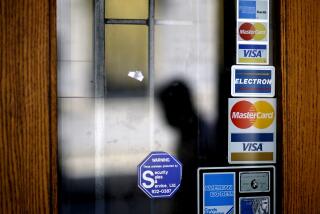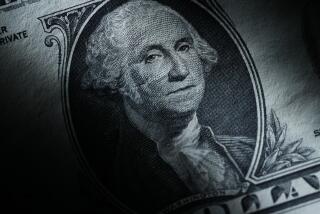Plunging CD Yields Spell a Nightmare for Older Investors
- Share via
For millions of people who rely on their bank or S&L; interest to live, October brings the annual day of reckoning--when savers must decide whether to roll over certificates of deposit they opened a year earlier.
This year, the reckoning will be more painful than ever for many savers. The broad decline in interest rates during the past 12 months has pulled CD yields down to their lowest levels since the 1970s. For people who survive on their interest earnings, this is a nightmare come true.
Indeed, the shock of CD yields of less than 6% will probably spark a flurry of activity on the part of savers and financial institutions. More people may flee CD accounts in favor of bonds or stocks, joining other investors who have poured billions of dollars into those riskier investments this year in search of higher returns.
Banks and S&Ls; will have to placate their angry and confused customers with new product suggestions, promotional giveaways or better service. Or at least, the institutions that care about keeping deposits will do those things. Troubled banks and S&Ls; that are shrinking anyway may be content to let money walk out the door.
October historically has been a big month for CD rollovers because the federal government deregulated all CD yields in October, 1983. Many savers took out six-month or one-year CDs then and have simply rolled them over repeatedly since.
That was profitable enough in the 1980s, when CD yields were mostly above 7.5%. Even a year ago, the national average yield of a one-year CD was 7.85%, says Bank Rate Monitor, a North Palm Beach, Fla., newsletter that tracks rates.
Today, however, the national average yield on a one-year CD is a mere 5.76%. To elderly people dependent on interest income that decline can be a crushing blow:
* A retired saver who put $200,000 into a one-year CD last September at 7.85% earned $15,700 in interest during the past year.
* At the current average yield of 5.76%, that $200,000 nest egg will earn just $11,520 in interest during the next year--a 27% drop in income to the saver.
Worse, by October, CD yields should be even lower than they are now, said Robert Heady, publisher of Bank Rate Monitor. “The consumer is in for another rate shock,” he said, because the cut in the banks’ prime lending rate last week, to 8% from 8.5%, will almost certainly mean that CD yields will drop another quarter-point or so during the next six to eight weeks.
Many savers know that the dramatic plunge in interest rates this year is a side effect of the extraordinarily weak U.S. economy. As demand for money has fallen, so have interest rates. Banks and S&Ls; aren’t lending as much, so they need not pay as much for deposits.
A much bigger force also is at work on rates, said Jerry Jordan, economist at First Interstate Bancorp in Los Angeles.
In the 1980s, the baby boom generation borrowed heavily to support its collectively expensive lifestyle. Their loans were funded in part by the bank deposits of older Americans--who were paid hefty yields for their trouble.
Now, as the grown-up baby boomers borrow less (or not at all), demand for their parents’ and grandparents’ savings has diminished--and, with it, the handsome interest earnings.
Payback, as they say, is heck. While older people profited at the expense of younger people in the 1980s, “now the older age group is losing to the benefit of the younger age group,” Jordan notes, as loan rates fall.
The answer for some older people who have depended on short-term CD interest all these years is to look for better returns elsewhere.
The total amount held in CDs at banks and S&Ls; nationwide has fallen $56 billion since February. Meanwhile, upward of $6 billion a month has been flowing into bond mutual funds, which pool investors’ dollars to buy Treasury, corporate, municipal or mortgage bonds.
Yields on bond funds range from 6% to 8.5% and higher. Unlike a CD, however, the principal value of a bond fund isn’t guaranteed. You can lose money over time if the bonds default or if market interest rates rise so that your older bonds are worth less.
Because of that risk, most bankers don’t see a tidal wave of money leaving CDs for bonds, even if CD yields fall further. Conservative savers will stay put, bankers believe. “A lot of our customers are at the stage in life where they don’t have time to earn (a nest egg) again” should they lose it, said Dick Kremer, officer at Coast Federal Bank in Los Angeles.
Still, bankers know that lousy yields will drive more savers to shop for an “edge” to make them feel better about staying in CDs. So those banks and S&Ls; that want to hang on to deposits in the October renewal period are looking for ways to bolster their image with unhappy savers:
* “Premiums”--cash or gift incentives for opening a CD account--may make a big comeback for the first time since the early ‘80s. Coast Federal has begun offering depositors discount certificates for airline tickets on Northwest Airlines.
Bank of America this week will begin offering cash bonuses to CD customers who deposit $10,000 or more and who join a special checking account plan. A $10,000 deposit in a two-year CD will earn a $100 bonus.
* Some S&Ls; are offering customers the ability to transfer their money in house, to non-CD investments. Often, the S&Ls; hope that rather than lose all of a customers’ savings to bonds or other higher-paying, uninsured investments, they can keep some of the money by offering a better-paying alternative for a piece of the account.
California Federal Bank customers, for example, can invest in stock or bond funds or insurance-company annuities.
* Some S&L; branch managers are taking matters into their own hands. Hank Valencia, who manages the Camarillo branch of Valley Federal Savings, has been actively “telemarketing” his services to customers.
He knows he can’t compete on rates with bonds and other riskier investments, but, he said, “if rates can’t do it, service has to do it. . . . A person likes to have someone scratch his back.”
Still, just how many bank and S&L; customers will be willing to stick with their low-yielding savings--and for how long--remains a trillion-dollar question. Despite the risk entailed in bonds and stocks, a long period of low returns on CDs could send more savers in search of something more exciting.
Parker Bartlett, a 71-year-old Santa Monica investor, says his objective is to earn 15% a year on his investments, and he knows he can only hope to get that in stocks and bonds--not CDs. He doesn’t hide his scorn for the low yields banks and S&Ls; pay now. “I can’t afford a mausoleum sitting on a high-priced piece of real estate,” he jokes about banks. “Let someone else pay for them.”
Southland Yields: Better than Elsewhere
Yields on bank and S&L; money market accounts and CDs in Southern California have fallen sharply this year, but not as sharply as rates elsewhere in the nation. The result: Yields here now are above the national averages.
National average L.A. average Account Jan. 1 Now Jan. 1 Now MMDA* 5.91% 5.12% 5.60% 5.21% 6-mo. CD 7.26% 5.50% 7.23% 5.55% 1-year CD 7.35% 5.76% 7.25% 5.78% 2 1/2-year CD 7.48% 6.28% 7.29% 6.39% 5-year CD 7.72% 6.95% 7.52% 7.15%
* Money market deposit account
Source: Bank Rate Monitor
How CD Yields Have Shrunk Savers who go to renew their one-year certificates of deposit at banks and S&Ls; in the next few weeks will find they’re being offered the lowest rates since the CDs were created in the e 1980’s.
Average Yield,1 yr. CD: Sept. ‘84: 11.60% Sept. ‘85: 8.11% Sept. ‘86: 6.27% Sept. ‘87: 7.24% Sept. ‘88: 7.98% Sept. ‘89: 8.31% Sept. ‘90: 7.85% Sept. ‘91: 5.76% Rates at mid-month. Source: Bank Rate Monitor
More to Read
Inside the business of entertainment
The Wide Shot brings you news, analysis and insights on everything from streaming wars to production — and what it all means for the future.
You may occasionally receive promotional content from the Los Angeles Times.










